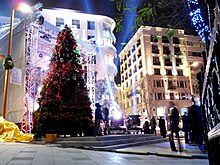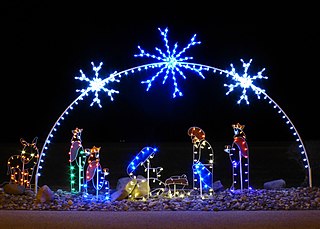
Christmas is an annual festival commemorating the birth of Jesus Christ, observed primarily on December 25 as a religious and cultural celebration among billions of people around the world. A feast central to the Christian liturgical year, it follows the season of Advent or the Nativity Fast, and initiates the season of Christmastide, which historically in the West lasts twelve days and culminates on Twelfth Night. Christmas Day is a public holiday in many countries, is celebrated religiously by a majority of Christians, as well as culturally by many non-Christians, and forms an integral part of the holiday season surrounding it.

A Christmas tree is a decorated tree, usually an evergreen conifer, such as a spruce, pine or fir, or an artificial tree of similar appearance, associated with the celebration of Christmas.
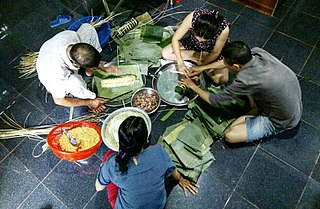
Tết, short for Tết Nguyên Đán, is the most important celebration in Vietnamese culture. Tết celebrates the arrival of spring based on the Vietnamese calendar, which is mostly based on the lunisolar Chinese calendar and usually has the date in January or February in the Gregorian calendar.

Christmas Eve is the evening or entire day before Christmas Day, the festival commemorating the birth of Jesus. Christmas Day is observed around the world, and Christmas Eve is widely observed as a full or partial holiday in anticipation of Christmas Day. Together, both days are considered one of the most culturally significant celebrations in Christendom and Western society.

In the Gregorian calendar, New Year's Day is the first day of the year; 1 January. Whilst most solar calendars begin the year regularly at or near the northern winter solstice, cultures that observe a lunisolar or lunar calendar celebrate their Lunar New Year at less fixed points relative to the solar year.

In the Gregorian calendar, New Year's Eve, also known as Old Year's Day or Saint Sylvester's Day in many countries, is the evening or the entire day of the last day of the year, 31 December. The last day of the year is commonly referred to as “New Year's Eve”. In many countries, New Year's Eve is celebrated with dancing, eating, drinking, and watching or lighting fireworks. Some Christians attend a watchnight service. The celebrations generally go on past midnight into New Year's Day, 1 January.
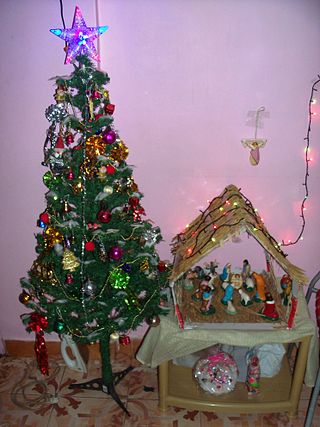
Christmastide is a season of the liturgical year in most Christian churches. In some, Christmastide is identical to Twelvetide.

The observance of Christmas around the world varies by country. The day of Christmas, and in some cases the day before and the day after, are recognized by many national governments and cultures worldwide, including in areas where Christianity is a minority religion. In some non-Christian areas, periods of former colonial rule introduced the celebration ; in others, Christian minorities or foreign cultural influences have led populations to observe the holiday.

Ded Moroz or Morozko is a legendary figure similar to Saint Nicholas, Father Christmas, and Santa Claus who has his roots in Slavic mythology. The tradition of Ded Moroz is mostly spread in East Slavic countries and is an important part of Russian culture. At the beginning of the Soviet era, communist authorities banned Ded Moroz. Nevertheless, he soon became an important part of the Soviet culture. The literal translation of Ded Moroz is Grandfather Frost.

A Christmas decoration is any of several types of ornamentation used at Christmastide and the greater holiday season. The traditional colors of Christmas are pine green (evergreen), snow white, and heart red. Gold and silver are also prevalent, as are other metallic colours. Typical images on Christmas decorations include Baby Jesus, Father Christmas, Santa Claus, and the star of Bethlehem.

The League of Militant Atheists, also Society of the Godless or Union of the Godless, was an atheistic and antireligious organization of workers and intelligentsia that developed in Soviet Russia under influence of the ideological and cultural views and policies of the Communist Party of the Soviet Union from 1925 to 1947. It consisted of party members, members of the Komsomol youth movement, those without specific political affiliation, workers and military veterans.

Christmas is the Christian celebration of the birth of Jesus Christ, which, in Western Christian Churches, is held annually on 25 December. For centuries, it has been the subject of several reformations, both religious and secular.

Novy God is the Russian phrase for "New Year", and also designates the Russian New Year's Eve and New Year's Day celebration.

Santa Claus, also known as Father Christmas, Saint Nicholas, Saint Nick, Kris Kringle, or simply Santa, is a legendary figure originating in Western Christian culture who is said to bring gifts during the late evening and overnight hours on Christmas Eve. He is said to accomplish this with the aid of Christmas elves, who make the toys in his North Pole workshop, and with the aid of flying reindeer who pull his sleigh through the air.

Jul, the Danish Jule and Christmas, is celebrated throughout December starting either at the beginning of Advent or on 1 December with a variety of traditions. Christmas Eve, Juleaften, the main event of Jul, is celebrated on the evening of 24 December, the evening before the two Christmas holidays, 25 and 26 December. Celebrating on the eve before Christmas is also used for most other holidays in Denmark.

Traditional Ukrainian Christmas festivities start on Christmas Eve, which is celebrated from December 24 to January 6, the date of the celebration of the baptism of Jesus, known in Ukraine as Vodokhreshche or Yordan, according to the Gregorian calendar and Revised Julian calendar by the Orthodox Church of Ukraine, the Catholic Church, and most Protestants.
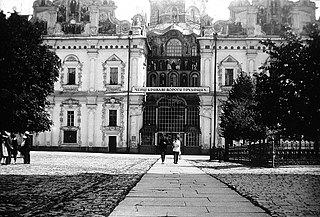
The USSR anti-religious campaign of 1928–1941 was a new phase of anti-religious campaign in the Soviet Union following the anti-religious campaign of 1921–1928. The campaign began in 1929, with the drafting of new legislation that severely prohibited religious activities and called for an education process on religion in order to further disseminate atheism and materialist philosophy. This had been preceded in 1928 at the fifteenth Party congress, where Joseph Stalin criticized the party for failure to produce more active and persuasive anti-religious propaganda. This new phase coincided with the beginning of the mass collectivization of agriculture and the nationalization of the few remaining private enterprises.

Christmas in Iceland (Jól) starts four weeks before proper Christmas, which begins on 24 December (Aðfangadagur) and ends thirteen days later on 6 January (Epiphany).
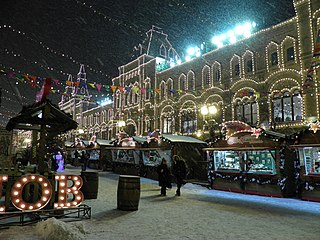
Christmas in Russia, called Е́же по пло́ти Рождество Господа Бога и Спа́са нашего Иисуса Христа in the Russian Orthodox Church, is a holiday commemorating the birth of Jesus Christ. It is celebrated on 25 December in the Julian calendar followed by the Eastern Orthodox Church and 7 January in the Gregorian calendar. It is considered a high holiday by the church, one of the 12 Great Feasts, and one of only four of which are preceded by a period of fasting. Traditional Russian Christmas festivities start on Christmas Eve, which is celebrated on 6 January [O.S. 24 December].

Christmas in France is a major annual celebration, as in most countries of the Christian world. Christmas is celebrated as a public holiday in France on December 25, concurring alongside other countries.

